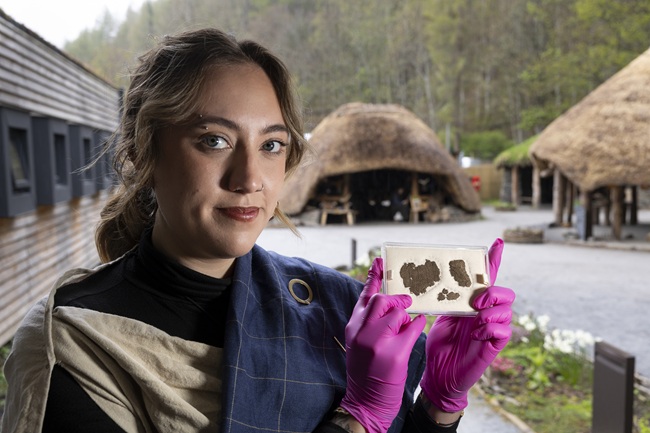Rare surviving piece of Scottish Iron Age textile goes on public display
Published: 23 April 2025
A fine piece of woven fabric, believed to be one of the oldest of its kind in Britain and dating back to the early to middle part of the Iron Age, goes on public display.

Believed to be one of the oldest of its kind in Britain and dating back to the early to middle part of the Iron Age, it was found in 1979 when an Iron Age loch dwelling house, known as the Oakbank Crannog, was excavated on Loch Tay.
Now, the public will be able to see this ancient textile close-up when it goes on show for the first time at The Scottish Crannog Centre’s Iron Age village, visitor centre and museum, on the banks of Loch Tay.
Previously thought too fragile to go on display, the textile will become a permanent exhibit at the Centre. Thanks to a painstaking stabilisation and conservation process, funded by Museums Galleries Scotland, it will be housed safely in a climate-controlled cabinet.
The ‘Oakbank Textile,’ has been analysed by archaeologists at the University of Glasgow who have radiocarbon dated the material to between 480 - 390BC.
Maureen Kerr, an experimental archaeologist and volunteer at the Centre, said: “The exciting thing is that there’s nowhere else in Scotland, and very few places in the rest of the UK, that has a textile of this size and age.
“The weave on this fine textile is called a 2/1 twill which is really unusual for the time in southern Britain and northern Europe as most twill weaves were 2/2. This sheds considerable light on the technologies society had in the Iron Age.
“Twill weaves, which this textile is part of, is a dense, flexible fabric, very similar in appearance to our modern denim weave. It has been made, we think, on a two-beam loom, or a warp-weighted loom.
"This, combined with the fact that there are the remnants of a possible hem indicating that it could have been part of a piece of clothing, makes it a rare and special discovery.”
Dr Susanna Harris, Senior Lecturer in Archaeology at the University of Glasgow, carefully examined the textile on behalf of the Centre.
She said: “There are very few early textiles of this date and we think this is the first one of this type, of 2/1 twill, in Scotland. Wool was such an important material in Scotland it’s been exciting to analyse this piece.
“It’s great that the Scottish Crannog Centre has taken this step. It’s really important finds like this go on display. It may be a small piece of textile but it tells us a lot about the heritage of Scottish textiles.”
Mike Benson, Director of The Scottish Crannog Centre added: “We are absolutely thrilled to be able to invite the public to come and see this amazing find.
"This piece would have been made by a whole community, from the shearing of the sheep, to the processing and dyeing of the wool to the weaving of the textile.
"Our Centre today is very much about community and the one thing that unites all of us is our common humanity through the ages.
"Through our work with communities and like-minded organisations, we invite all kinds of people to our Centre, for instance, refugees and people struggling with their mental health. As well as making our prehistoric history accessible to all, we’re also making history together through the different interpretations people bring to our artefacts. It’s been amazing to hear the fresh insights people from other cultures and backgrounds can offer.
“We're really looking forward to finding out what people make of this rare textile, which is part of our past but also a hugely important part of our present and future. We hope people will be drawn to see this exhibit, and the rest of our extensive collection, for years to come.”
Crannogs were dwelling houses built on stilts or stone over water and usually had a bridge connecting them to the shore. Very few exist outside of Scotland and Ireland. The first crannogs in Scotland were built on lochs from Neolithic times.
In 2021 the Scottish Crannog Centre was dealt a devastating blow in 2021 when a fire burned down the site’s reconstructed crannog, built by archaeologists in 1997.
The Centre opened to visitors on its new and enlarged site near Kenmore last year and the build team is well on the way to completing a new crannog using sustainable and historical construction methods.
First published: 23 April 2025

